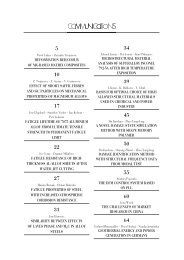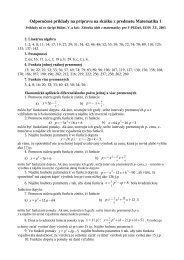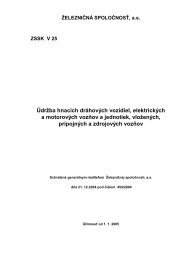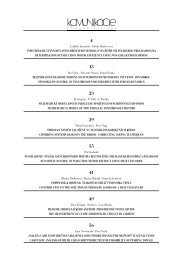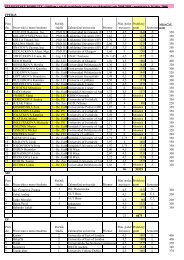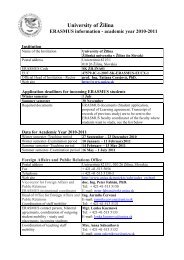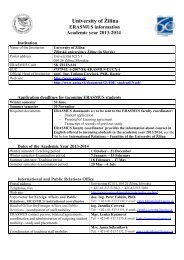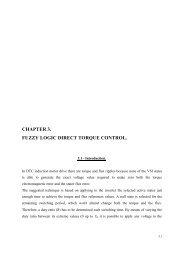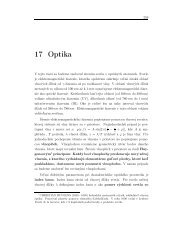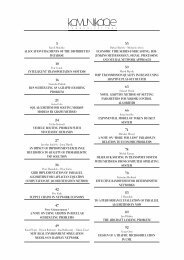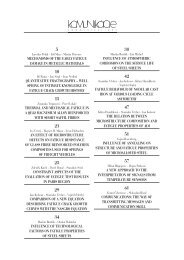simulation of torsion moment at the wheel set of the railway vehicle ...
simulation of torsion moment at the wheel set of the railway vehicle ...
simulation of torsion moment at the wheel set of the railway vehicle ...
You also want an ePaper? Increase the reach of your titles
YUMPU automatically turns print PDFs into web optimized ePapers that Google loves.
REVIEWThe processing results from <strong>the</strong> two systems are comparedand in case <strong>the</strong>y are not identical, <strong>the</strong> comparing function itselfand <strong>the</strong> next safety action must redirect <strong>the</strong> system into a safe-sideposition. This concept is possible with <strong>the</strong> configur<strong>at</strong>ions ‘2 out <strong>of</strong>2’ and ‘2 out <strong>of</strong> 3’.These are <strong>the</strong> main problems th<strong>at</strong> every system must solveand <strong>the</strong> ‘internal mechanisms’ th<strong>at</strong> must achieve <strong>the</strong> above failsafebehavior:• Every single failure must be identified and must result in a safetyreaction <strong>of</strong> <strong>the</strong> system;• Double or multiple failures cannot happen if <strong>the</strong> safety concept<strong>of</strong> <strong>the</strong> system enables full comparison <strong>of</strong> results (during <strong>the</strong>entire course <strong>of</strong> <strong>the</strong> processing, and not only <strong>at</strong> its end) andcondition <strong>of</strong> both channels, including memories;• Not a single failure in one channel can have a similar effecton <strong>the</strong> o<strong>the</strong>r channel. The channels must be independent fromeach o<strong>the</strong>r;• Both channels and <strong>the</strong> whole module must be completely testedand with no mistakes in ei<strong>the</strong>r hardware or s<strong>of</strong>tware beforereleasing <strong>the</strong> system into work. In o<strong>the</strong>r words, <strong>the</strong> systemmust be guaranteed as mistake-free before starting up <strong>the</strong>system.So, this obviously shows th<strong>at</strong> <strong>the</strong> work <strong>of</strong> both processors andall <strong>the</strong> activities th<strong>at</strong> are rel<strong>at</strong>ed to fur<strong>the</strong>r process oper<strong>at</strong>ion arecontrolled in <strong>the</strong> earliest phase <strong>of</strong> every tact.This early control, as an internal mechanism for identifyingmistakes even in <strong>the</strong> earliest phase, is supported by a special additionalchecking program, which periodically checks <strong>the</strong> completest<strong>at</strong>us <strong>of</strong> <strong>the</strong> system. Also, all <strong>the</strong> inside d<strong>at</strong>a, before <strong>the</strong>ir entryinto <strong>the</strong> memory, are subject to autom<strong>at</strong>ic comparison and correction.It is clear th<strong>at</strong> this kind <strong>of</strong> safety concept assumes safety functions<strong>of</strong> <strong>the</strong> tact-giver and <strong>the</strong> compar<strong>at</strong>or, implying th<strong>at</strong> <strong>the</strong>y mustbe ‘fail-safe’ designed, i.e. th<strong>at</strong> every mistake on one <strong>of</strong> <strong>the</strong> elements<strong>of</strong> <strong>the</strong>se modules must be reflected in <strong>the</strong> ultim<strong>at</strong>e instancein <strong>the</strong> content <strong>of</strong> <strong>the</strong> BUS signal.Fig. 1 shows an illustr<strong>at</strong>ive example <strong>of</strong> a basic two-channelconfigur<strong>at</strong>ion <strong>of</strong> <strong>the</strong> safety microcomputer by Siemens Company.This configur<strong>at</strong>ion is safe-designed so th<strong>at</strong> <strong>the</strong> two identical microcomputerswork in synchrony with <strong>the</strong>ir:• Central processing units CPU 1 and CPU 2;• Belonging memories for entering and reading <strong>of</strong> <strong>the</strong> RAM 1and RAM 2 d<strong>at</strong>a;• Memories which are programmed for fixed values th<strong>at</strong> can bereprogrammed as needed, EPROM 1 and EPROM 2;• The configur<strong>at</strong>ion contains common ingoing and outgoingmodules;• Reception (1) and Release (2) which establish connection with<strong>the</strong> exterior elements; <strong>the</strong> system has one common tact-giverto synchronize <strong>the</strong> work <strong>of</strong> <strong>the</strong> two identical channels.The system checks if <strong>the</strong> signals from both channels are identicalin every tact step, in <strong>the</strong> following way: <strong>the</strong> tact-giver turns onboth processors (TACT 1 and TACT 2) and a compar<strong>at</strong>or (‘C’ signal– control in Fig. 1) The compar<strong>at</strong>or checks <strong>the</strong> content <strong>of</strong> <strong>the</strong> collectorsin both microcomputers (BUS 1 and BUS 2) and compares<strong>the</strong>m. Only in case th<strong>at</strong> <strong>the</strong> compar<strong>at</strong>or (in every tact)establishes <strong>the</strong> identical st<strong>at</strong>us <strong>of</strong> both channels, it gener<strong>at</strong>es <strong>the</strong>signals “OK” (no mistake) on its exit, which triggers <strong>the</strong> nextworking cycle <strong>of</strong> <strong>the</strong> tact-giver.O<strong>the</strong>rwise, in case <strong>the</strong>re is any discrepancy in <strong>the</strong> signalscoming from Channel 1 and Channel 2, which is transparentlyshown on BUS 1 and BUS 2, or in case <strong>of</strong> any mistake on <strong>the</strong>compar<strong>at</strong>or, <strong>the</strong> compar<strong>at</strong>or ‘chokes’ <strong>the</strong> ‘OK’ (no mistake) signaldriving <strong>the</strong> tact-giver into rest, which ultim<strong>at</strong>ely means stopping<strong>the</strong> process: <strong>the</strong> whole configur<strong>at</strong>ion (module) stops its work directing<strong>the</strong> system to <strong>the</strong> ‘safe side’.Fig. 1 Basic structure <strong>of</strong> <strong>the</strong> two-channel safety microcomputer2. Principles <strong>of</strong> safety in <strong>the</strong> <strong>railway</strong> signalling systemsThe signalling systems are not immune from failure and,<strong>the</strong>refore, due to <strong>the</strong>ir specific role, <strong>the</strong>y must be designed andconstructed so th<strong>at</strong> even in case <strong>of</strong> disturbance and failure <strong>the</strong>y donot endanger <strong>the</strong> safety <strong>of</strong> <strong>the</strong> traffic, which implies th<strong>at</strong> <strong>the</strong>y mustbe signal-safe and technically-safe.This ‘fail-safe’ behavior is achieved by implement<strong>at</strong>ion <strong>of</strong> <strong>the</strong>signalling principles and safety criteria and using highly reliabledevices regardless <strong>of</strong> <strong>the</strong> technology.As a defined measure <strong>of</strong> safety, <strong>the</strong> intern<strong>at</strong>ional <strong>railway</strong> organiz<strong>at</strong>ionUIC, i.e. its committee ORE, has defined in its recommend<strong>at</strong>ionson <strong>the</strong> basis <strong>of</strong> so far experience and <strong>the</strong> achievedlevel <strong>of</strong> technical development ‘<strong>the</strong> mean time between two dangerousfailures’ – ‘MTBF’, as a reliability measure in between two58 ● COMMUNICATIONS 3/2008



